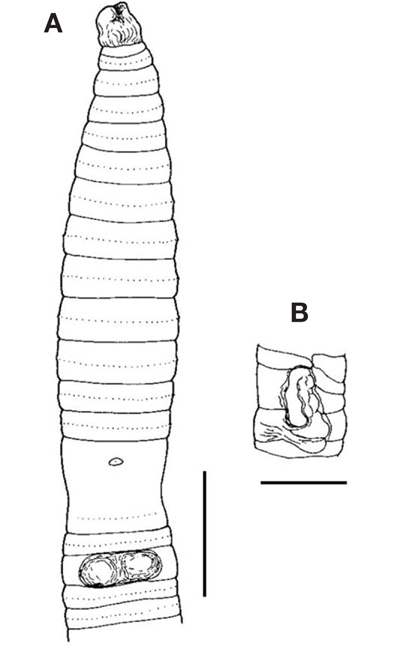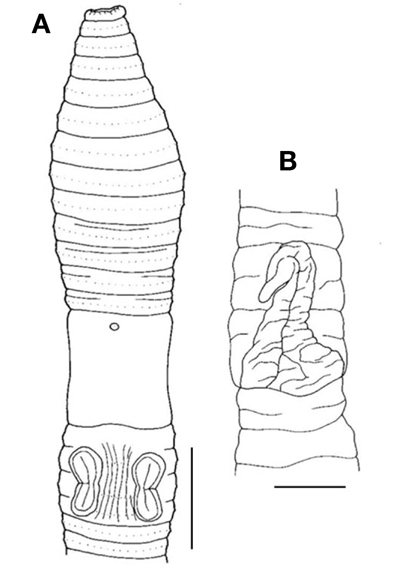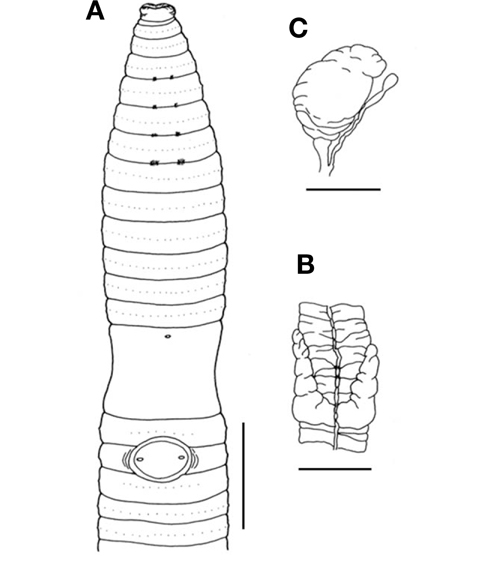



Southeast Asia is particularly interesting because the dominant elements of the East Asian earthworm fauna are Australasian in origin (Sims and Easton, 1972). Southeast Asia is the most likely avenue for the colonization of East Asia by earthworms of the
The earthworm fauna of Laos is little-studied. Previous study of the earthworms of Laos can be found in Thai and Samphon (1988, 1989, 1990a, 1990b, 1991a, 1991b), Hong (2008), Hong et al. (2008), and Hong (2010).
This paper reports species of
In this paper, three species that are new to science are reported from Nam Ha, northern Laos:
The specimens were found in soils and litter layers in forests. Illustrations are of anatomical views containing important characters, prepared with a camera lucida. Descriptions are based on the external examination and dorsal dissection under the microscope. Measurements are in millimeters. The holotype and paratypes are deposited in the Biology Department, Faculty of Science, National University of Laos, Vientiane (BDNUL).
Order Haplotaxida Grube, 1850 Family Megascolecidae Rosa, 1891 Genus Amynthas Kinberg, 1867
>
Amynthas namhaensis Hong and James sp. nov. (
Material examined. Holotype: clitellate (BDNUL 0023): Laos, Laung Namtha Province, Nam Ha NPA, Keua Lome Mountain (21° 08.161′N, 101° 17.025′E), 1,177 m, soil and litter layers, good forest condition with grass understorey, sandy soil, 6 Sep 2006, K. Inkhavilay, Vanh, and Tear colls. Paratypes: 2 clitellates (BDNUL 0026, BDNUL 0027); same data as for holotype. Non-type material: 3 clitellates, 1 aclitellate, same data as for holotype.
Diagnosis. Spermathecal pores absent; male porophores transverse oval pads meeting mid-ventrally in elevated area 2.2-2.4 mm, surrounded by outer rings; pores 0.14-0.17 circumference apart ventrally, intestinal caeca simple, genital markings lacking.
Description. Unpigmented. Dimensions 70-80 mm, by 3.2-3.5 mm at segment X, 3.1-3.7 mm at segment XXX, 2.9-3.0 mm at clitellum; segments 75-100. Setae slightly more crowded ventrally, numbering 43-47 at VII, 43-53 at XX, 0 between male pores, setal formula AA:AB:ZZ:YZ =2:1:3:2 at XIII. Female pore single in XIV, on 0.3-0.5 mm oval porophore. Prostomium epilobic with tongue open, clitellum coffee color, formalin preservation. First dorsal pores at 10/11. Clitellum annular XIV-XVI; setae invisible externally.
Male field bound by transverse rectangular-oval furrow spanning 20 intersetal intervals between 17/18 and 18/19; grooves within paired circular pads almost meeting midventrally; pores 0.14-0.17 circumference apart ventrally. No spermathecal pores. Genital markings absent.
Septa 5/6-7/8 thick, 8/9 thin, 9/10 absent, 10/11-12/13 thin. Gizzard globular in VIII. Intestine begins in XV, lymph glands not found. Typhlosole medium sized found from XXVI. Intestinal caeca simple, originating in XXVII, and extending anteriorly about to XXV, small and flattened oval sac. Esophageal hearts four pairs in X-XIII. Male sexual system holandric, testes and funnels in ventrally joined sacs in X-XI. Seminal vesicles small, two pairs in XI-XII. Prostates confined to XVIII; one or both glands absent in some specimens; prostate ducts muscular, vasa deferentia terminate in XVIII. Genital papilla glands absent.
Ovaries in XIII. Spermathecae absent. Genital marking glands not found.
Etymology. The species is named for its type locality, Nam Ha NPA.
Distribution. Laos.
Remarks.
>
Amynthas vanhi Hong and James sp. nov. (
Material examined. Holotype: clitellate (BDNUL 0024): Laos, Laung Namtha Province, Nam Ha NPA, Keua Lome Mountain (21° 08.161′N, 101° 17.025′E), 1,177 m, soil and litter layers, good forest condition with grass understorey, sandy soil, 6 Sep 2006, K. Inkhavilay, Vanh, and Tear colls. Paratype: 1 clitellate (BDNUL 0028); same data as for holotype.
Diagnosis. Spermathecal pores lacking; male porophore pads human foot print-shaped, set longitudinally; pores 0.17-0.19 circumference apart; paired genital papillae in XVII in line with male porophores, larger numbers of setae in head than in post-clitellar segments, cupped zig-zag folded typhlosole, intestinal caeca simple.
Description. Unpigmented. Dimensions 58-65 mm, by 3.5- 3.8 mm at segment X, 3.0-3.5 mm at segment XXX, 3.2- 3.5 mm at clitellum; segments 112. Setae regularly distributed around segmental equators numbering 65-66 at VII, 43- 52 at XX, 2-3 between male pore, setal formula AA:AB: ZZ:YZ=2:2:1:1 at XIII. Female pore single in XIV, on 0.3- 0.4 mm circular porophore. Prostomium epilobic with tongue open, clitellum light brown, formalin preservation. First dorsal pores at 9/10. Clitellum annular XIV-XVI; setae invisible externally.
Male porophores human foot print-shaped, set longitudinally, concave laterally, extending to segment XX; 0.9-1.0 mm wide; male pores equatorial on segment XVIII at anterior ends of seminal grooves, extending posteriorly to equator of XX, near lateral margins of pads 0.17-0.19 circumference apart ventrally. Spermathecal pores absent. Epidermal thickenings paired, postsetal in XVII close to male porophores
Septa 5/6-7/8 thick, 8/9-10/11 absent, 11/12 muscular, 12/13 thin. Gizzard globular in VIII-X. Intestine begins in XV, lymph glands not found. Typhlosole simple fold XXIIXXV, from XXVI-XXVII deep zig-zag folds with lateral edges curved posteriorly as cupped folds, ventral edges join continuous straight mid-ventral ridge. Simple digitate intestinal caeca, originating in XXVII, extending about to XXIII. Esophageal hearts four pairs in X-XIII; those of XIII largest. Male sexual system holandric, testes and funnels in ventrally paired sacs in X, dorsally united sacs in XI. Testes sac of XI encloses hearts, seminal vesicles. Seminal vesicles two pairs in XI-XII well developed with dorsal lobes. Prostates in XVIII, extending over XVI-XXIII; short bent fusiform muscular ducts, glands large, thick, each divided into several lobes. Genital papilla glands lacking.
Ovaries in XIII. No spermathecae. Genital marking glands absent.
Etymology. The species is named for Mr. Vanh, one of the collectors.
Distribution. Laos.
Remarks. The present species is similar to
>
Amynthas angtanensis Hong and James sp. nov. (
Material examined. Holotype: clitellate (BDNUL 0025): Laos, Laung Namtha Province, Nam Ha NPA, Angtan Mountain (21° 08.590′N, 101° 16.417′E), 1,351 m, soil and litter layers, good forest condition, thick surface litter layer over black soil, 7 Sep 2006, K. Inkhavilay, Vanh, and Tear colls. Paratypes: 2 clitellates (BDNUL 0029, BDNUL 0030); same data as for holotype.
Diagnosis. Spermathecae four pairs V-VIII; male field a transverse oval between eq. XVII, eq. XIX; spanning 10 intersetal intervals, bound by a furrow; male pores superficial on small round porophores at lateral ends of oval area, within furrow boundary.
Description. Unpigmented. Dimensions 35-46 mm, by 2.8-3.0 mm at segment X, 2.0-2.6 mm at segment XXX, 2.2-2.7 mm at clitellum; body very small, segments 66-94. Setae slightly more crowded ventrally, numbering 34-37 at VII, 32-37 at XX, 0 between male pore, setal formula AA: AB:ZZ:YZ=2:1:3:2 at XIII. Female pore single in XIV, on 0.2-0.3 mm circular porophore. Prostomium epilobic with tongue open, clitellum coffee color, formalin preservation. First dorsal pores at 12/13. Clitellum annular XIV-XVI; setae invisible externally.
Male field a transverse oval between eq. XVII, eq. XIX; spanning 10 intersetal intervals, bounded by a furrow; male pores superficial on small round porophores at lateral ends of oval area, within furrow boundary, 0.07-0.1 circumference apart ventrally. Spermathecal pores four pairs in 4/5- 7/8, 0.06-0.08 circumference apart ventrally. Genital markings lacking.
Septa 5/6-7/8 thick, 8/9/10 absent, 10/11-13/14 thin. Gizzard large in VIII-X. Intestine begins in XV, lymph glands not found. Typhlosole low simple fold from XVIII. Intestinal caeca simple, originating in XXVII, and extending anteriorly to about XXIII, simple broad triangular sac. Esophageal hearts four pairs in X-XIII. Male sexual system holandric, testes and funnels in ventrally joined sacs in X, XI. Seminal vesicles paired, well developed in XI-XII with dordorsal lobes. Prostates in XVII, extending between XVI-XXI; glands divided into 3-4 small lobes, ducts short with one sharp curve, large fusiform and muscular.
Ovaries in XIII. Spermathecae four pairs in V-VIII; ampulla irregular-ovate, stout ducts shorter than ampulla, iridescent diverticulum chamber egg-shaped, with stalk, longer than ampulla, no nephridia on spermathecal ducts.
Etymology. The species is named for its type locality, Angtan Mountain.
Distribution. Laos.
Remarks.



